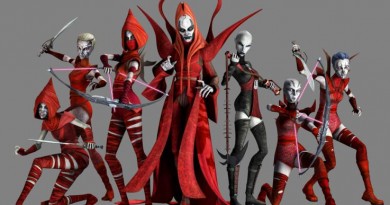The Heroine’s Journey: Defining Concepts
Last year the blog introduced the series Seeking Strong Female Heroines. In the first post, Tricia described the reason for the series – to highlight stories featuring these kinds of characters – and defined some of the core characteristics of strong female heroines. Since then, we’ve discussed a number of characters as strong female heroines: Princess Leia from the Star Wars movies, her daughter Jaina Solo and her sister-in-law Mara Jade Skywalker from the Expanded Universe, and Castle’s Kate Beckett. More Seeking SFH posts are in the works, including Alicia Florrick and the women of The Good Wife, Olivia Dunham from Fringe, Myka Bering from Warehouse 13, and Buffy Summers. Up next, of course, is Katniss Everdeen from The Hunger Games.
This year we’re adding a complementary series: the Heroine’s Journey. Inspired by some of our favorite stories, including The Hunger Games, as well as the story design and writing of Wynde, this series has a slightly different focus. Seeking SFH is mostly descriptive, identifying well-written strong female heroines and why they’re effective. The Heroine’s Journey series will do some of that, drawing insights from the small number of stories out there that already fit our concepts. But the main purpose of the Heroine’s Journey series is prescriptive – to help continue the push for more and better stories with great female leads by thinking about what would constitute the elements of a heroine-centered storytelling model parallel to the well-known Hero’s Journey monomyth.
Before we move into tackling that ambitious endeavor, though, we thought it was important to define several of our key concepts.
The Heroine’s Journey is a Mythic, Epic Coming of Age Tale
Many great stories with notable characters are not epic or mythic, and many others are not coming of age tales. Some of them feature female leads, or even strong female heroines, and they can bring hours of enjoyment to readers or an audience. But we have something more specific in mind for the Heroine’s Journey.
What Joseph Campbell identified in his research into the world’s myths was a particular type of story with a specific kind of resonance throughout numerous human cultures – the transformation of a young man from ordinary to extraordinary, triumphing over his adversaries and leaving him changed forever. This Hero’s Journey, also called the monomyth, has a core structure and common elements that still ring true across millennia.

Although grounded primarily in ancient myths and legends, Campbell’s Hero’s Journey has formed the basis of highly successful coming of age tales written in the modern world, as well. The most famous example, probably, is George Lucas directly consulting with Campbell while writing the first Star Wars movie. But there are other examples, too, including Orson Scott Card’s Ender’s Game and the film The Matrix. Many elements of Campbell’s progression also appear throughout the Harry Potter saga.
The Heroine’s Journey retains these two elements of Campbell’s model. Characters like Dana Scully, Olivia Dunham, Sarah Connor, and Mara Jade Skywalker participate in tales of epic proportion and mythic resonance, but they begin their stories as adults; while their adventures change them forever, they cannot fairly be called coming of age journeys. Likewise, there are numerous coming of age tales with young women at the center, but which lack mythic or epic qualities – just as they are countless sports movies where the most epic event in the protagonist’s life is making the winning play in the championship game at the end.
To qualify as a Heroine’s Journey in our formulation, then, the story must have substantial mythic and epic elements, and it must be a coming of age tale. This common ground with Campbell’s monomyth explains why some elements of the Heroine’s Journey will align with the Hero’s Journey. Yet there will be significant differences, as well, as upcoming posts in the series will explore. After all, the Heroine’s Journey has one crucial distinction – its primary character is a young woman.
The Heroine’s Journey has a Strong Female Heroine as its Lead Character
In one respect, the Heroine’s Journey is a subset of the Strong Female Heroine category – both require the traits of strength, femininity, and heroism. Strength comes in many forms, especially for women. In upcoming blogs, we’ll say more about what it means to ensure that a heroine’s female nature carries through in her portrayal. The key point for now is to emphasize that the Heroine’s Journey’s focus is not on young women as protagonists, but as heroes. Stories with dark themes are quite popular these days, and some strong female characters now are best identified with labels like antihero, anti-villain, or morally compromised hero. The “avenging angel” archetype, for example – Aeon Flux, Nikita, or the Bride from Kill Bill, to name a few – is often a strong female character, but she is rarely heroic. The protagonist of the Heroine’s Journey is not morally flawless, but she must be, in her heart, profoundly on the good side.

On the other hand, the Heroine’s Journey also requires something more than the Strong Female Heroine – that the heroine be the center of the story, as its principal character. In the Heroine’s Journey, the heroine’s transformation is the character development at the core of the tale, and she is the character around whom all the other characters’ paths orbit. Many of the popular recent strong female heroines are supporting characters to a young man’s Hero’s Journey: Princess Leia to Luke Skywalker, Padmé Amidala to Anakin Skywalker, or Hermione Granger to Harry Potter. In Pirates of the Caribbean: The Curse of the Black Pearl, Elizabeth Swann sets the story in motion, but by the end her character development becomes secondary to Will Turner and Jack Sparrow. Yet each of these characters was vibrant enough to have supported a Heroine’s Journey, had the storytellers been willing to commit to developing their character arcs as fully as the male lead’s. In the Heroine’s Journey, the story is the heroine’s – and everyone else’s character arcs support hers.
Unfortunately, very few existing stories meet both of these criteria. Two that do meet them have proven highly successful: The Hunger Games and Buffy the Vampire Slayer. As we discuss the Heroine’s Journey model further, Katniss and Buffy will be major touchstones for how to execute this kind of story effectively.
The Heroine’s Journey Might – or Might Not – Have a Happy Ending
Just as with the Hero’s Journey, nothing in the Heroine’s Journey model necessitates any particular type of ending to the character’s story. Some heroes triumph and live happily ever after; others sacrifice their lives to ensure victory, or pay a terrible price for succeeding in their quest. The key to the Heroine’s Journey is not her reward for victory, but how and why she fights, struggles, and perseveres to the end.
Among stories with strong female heroines, a wide range of fates befall them. Some follow the fairy tale structure and a happy, or hopeful, ending: Princess Leia in the original Star Wars trilogy, Hermione in Harry Potter, or Rapunzel in Tangled. Others face tragedy in the literary sense, and the painful destiny that comes with it: Padmé watches her husband fall to the dark side, betray the Republic, and turn against her in the Star Wars prequels; Katniss faces a bittersweet future with everlasting fear and loss by the end of Mockingjay. And some characters, especially those with the longer story arcs, end up with elements of both: Buffy’s life has both fairy tale highs and tragic lows throughout the seven seasons of her titular television series, as does Sydney Bristow’s character arc on Alias; in a similar fashion, Elizabeth Swann has a fairy tale arc in Curse of the Black Pearl but ends with a bittersweet, tragic fate by the end of Dead Man’s Chest. In the Heroine’s Journey, any one of these fates, or others, is possible.
Up Next: We discuss several problems with Campbell’s Hero’s Journey as it relates to the Heroine’s Journey, and why that necessitates differences in the Heroine’s Journey model.
B.J. Priester is editor of FANgirl Blog and contributes reviews and posts on a range of topics. A longtime Star Wars fandom collaborator with Tricia, he is also editing her upcoming novel Wynde. He is a law professor in Florida and a proud geek dad.











Pingback:Journey of a Strong Female Heroine: Katniss Everdeen « fangirlblog.com
Pingback:The Heroine’s Journey: How Campbell’s Model Doesn’t Fit « fangirlblog.com
Pingback:Guest Post by Maria Selke: Harnessing Fandom to Teach the Hero’s Journey
Pingback:Guest Post by Maria Selke: Harnessing Fandom to Teach the Hero’s Journey
Pingback:Women Centre Stage | Ruth Stalker-Firth
You might point out that this is predominantly an Anglo-Saxon, if not US American POV on coming-of-age, regardless of whether male or female.
Neither Katniss, nor Buffy are in my opinion “strong females” or even just positive role models.
Pingback:The Heroine’s Journey | Anne Bean
Pingback:The Heroine’s Journey Narrative Structure | Hunter's Writings
Pingback:Women and Storytelling: Saint, Spy, Suffragette | Ruth Stalker-Firth
Pingback:What is the Heroine’s Journey? | Melissa Burch
Hey Lex! I am a school teacher and would love to include this article in a virtual book I am creating for my mythology students. Can I use it? I would give you credit and link back to this site.
I wondered about this female heroic journey mostly since the new SW Trilogy was announced because I was pretty sure that a female character should be and have to be main character.
This Rey’s initiation as a second stage of monomyth is really puzzling me. And I would have been upset if there was not a female predominant aspect in Ep. 8.
I would be very intrigued by myths which would be strictly related to female initiation rituals in traditional societies.
Otherwise, I wondered how is different Jesus heroe’s journey compared to virgin Mary’s own journey. I once wrote done a few key aspects of Jesus monomyth but never tried at Mary’s monomyth. One very special aspect from Catholic Church POV is that Mary was the first true human being, not being a goddess (as Jesus is also God in this POV), to not die and so get immortality for both body and soul.
In a strange way, it is like Mary embodied the Lightside Jedi strict principles. Outside being granted the Holy Spirit (the Force) to give birth to her Son Jesus, she never got physically involved with Joseph (still Catholic POV).
A different question: is it that Heroin’s journey have to deal primarily, one way or another, with sex and nurturing life in an orderly (rather than chaotic) fashion as the central theme, hence all the “girly movies” about love relationships (gaining much larger feminine audience)?
As someone said somehow, men build houses and buildings but all lifes in them came from women.
Is Little Red Hood an archaic type of heroin’s journey (mother, daughter and grandmother) ?
All women having to deal with the big bad Wolf, one way or another?